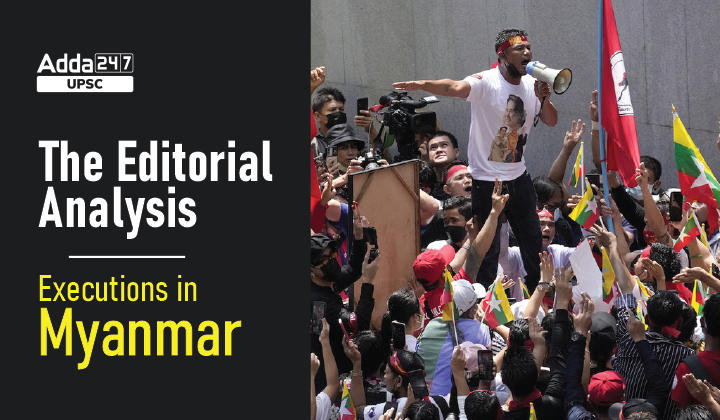Table of Contents
Executions in Myanmar- Relevance for UPSC Exam
- GS Paper 2: International Relations- Effect of policies and politics of developed and developing countries on India’s interests.
Executions in Myanmar in News
- In the past few days, a Myanmar kangaroo court sentenced country’s Nobel Prize winner and civilian leader, Aung San Suu Kyi, to a further six years imprisonment in addition to the 11 already handed down.
- In July, the Myanmar military (Tatmadaw) regime executed four democracy activists, including a former lawmaker.
- While the regime is known to deploy harsh measures, this was the first time since the 1980s that any democracy activist was executed.
- The executions followed repressions by Tatmadaw that include solitary confinement of Suu Kyi, prolonged detention of Australian economist Sean Turnell, and use of heavy weaponry and air power in civilian areas against resistance groups.
Myanmar Military Coup and Associated Issues
- Background: In February last year, Tatmadaw arrested the entire civilian leadership, installed a State Administrative Council to govern the country, and hoped for smooth control, but the coup has met with fierce resistance.
- Resistance against Military Regime: There is much diversity among the resistance; young adults, members of political parties, civil society, and even some government officials participate in the protests.
- There is a self-styled National Unity Government (NUG) of elected members of legislatures attempting to coordinate the resistance, and the People’s Defence Forces (PDFs), its armed wing, are conducting sporadic strikes on military targets.
Military Rule in Myanmar- Rise of Ethnic-based armed organisations (EAOs)
- Ethnic-based armed organisations (EAOs) have a long history of conflict with the military, and the ceasefire process has stalled after the coup.
- With public disillusion with military rule, many EAOs have scaled up operations against the regime and large parts of Myanmar are not under Tatmadaw’s control.
- The regime reportedly mobilised armed militias to contain the uprising but the opposition is not dispirited. Despite limited resources, the EAOs and PDFs demonstrate resilience in confronting the regime.
- A National Unity Consultative Council was set up to ensure they operate with a shared vision but ground level coordination is found wanting.
- While EAOs have relatively better command structures, the NUG fails to exercise adequate control of all PDFs.
Military Rule in Myanmar- Response of India, China and ASEAN
- ASEAN: There is a growing concern among ASEAN countries over its fellow-member Myanmar.
- ASEAN has, last year, drafted a five-point agenda to resolve the crisis, which included mediation by a Special Envoy.
- The current holder of this office is the Cambodian foreign minister, who this year travelled twice to Myanmar.
- Unable to meet any opposition leaders in detention, little progress was achieved, and he expressed his frustration by stating “even Superman cannot solve the Myanmar problem”.
- Support from China: China has never hinted that it could reconsider its economic interests in Myanmar; instead, it is inclined to enhance economic engagement.
- Due to Chinese Support, it appears the military regime is not unduly perturbed by censure from ASEAN despite significant economic interactions.
- India: There are concerns that New Delhi has not expressed sufficient concern about the executions in Myanmar.
- India can not afford to lose a geo-strategic ally like Myanmar, especially to China.
- The question is what India could do to facilitate a stable, federal democratic polity in our neighbour.
Conclusion
- Though the window of opportunity is narrow, India could adopt a three-pronged strategy-
- Collaborating with like-minded ASEAN countries;
- Urging Tatmadaw to start a genuine reconciliation process; and
- Preparing the political/administrative resources in Northeast India to provide humanitarian aid to affected people across the border.




 TSPSC Group 1 Question Paper 2024, Downl...
TSPSC Group 1 Question Paper 2024, Downl...
 TSPSC Group 1 Answer key 2024 Out, Downl...
TSPSC Group 1 Answer key 2024 Out, Downl...
 UPSC Prelims 2024 Question Paper, Downlo...
UPSC Prelims 2024 Question Paper, Downlo...
